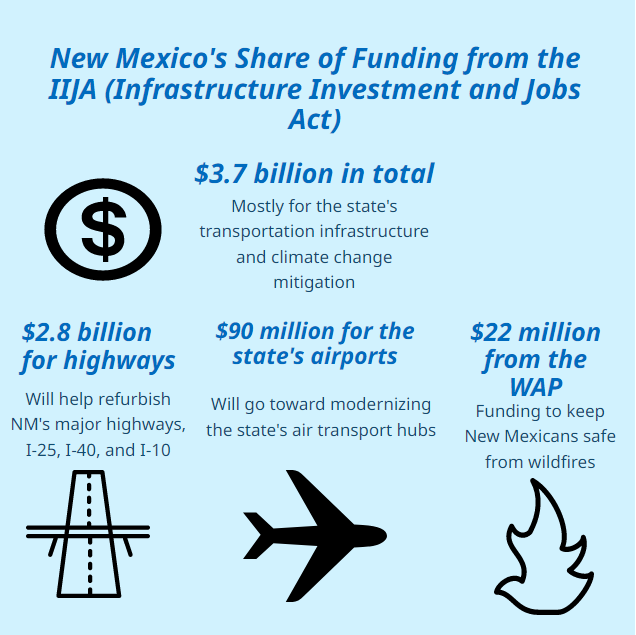Investments in New Mexico from the Bipartisan Infrastructure Bill
Funds for transportation infrastructure and living with climate change in the state
On November 15, 2021, President Joe Biden signed the Infrastructure Investment and Jobs Act into law, cementing the largest investment in American public works since the Eisenhower Administration’s Interstate Highway System was passed in the 1950s. The bill makes a series of investments that have been designated for specific communities across the country, including here in New Mexico.
The bill was passed after a monthslong back-and-forth between President Biden, the progressive and moderate factions of the Democratic caucus in the House of Representatives, and a group of Republican senators who negotiated the framework. The current law first originated as part of the American Jobs Plan, which President Biden proposed in March 2021. The plan was a $2.3 trillion proposal filled with Biden’s priorities including investments in clean and renewable energy and a slew of public works investments aimed at improving the economic opportunities for long-underserved communities of color. A group of Republicans, led by West Virginia Senator Shelley Moore Capito, soon engaged in negotiations aimed at passing a slimmed-down version of the bill, which culminated in an offer that allocated about $200 billion dollars for new investments, which Biden rejected for its narrow focus, noting that it cut out almost all of his ambitions on tackling the climate crisis, including increasing the use of renewable energy forms, and slashing emissions.
After the first round of negotiations failed, Republican Senator Rob Portman and Democratic Senator Kyrsten Sinema, aided by a small entourage of other moderates from both parties, including Democratic Senator Joe Manchin of West Virginia, pursued a bipartisan deal on infrastructure more suitable to President Biden’s goals. In late June, that group of senators joined President Biden outside of the West Wing to announce that a framework for a bipartisan infrastructure bill had been reached, with $550 billion of new spending aimed at upgrading roads, bridges, highways, airports, ports, and more, with another cluster of investments in President Biden’s clean energy agenda. Over the next couple of months, after intense negotiations to finalize the legislative text, the Senate wrapped up their work, and passed the bill in early August, by a vote of 69-30, with 19 Republicans crossing the aisle in support. The bill was stuck in a stalemate when it got to the House of Representatives, given that a sizable group of progressive Congress members wanted to pass the bill along with Biden’s Build Back Better plan, which contained trillions of dollars of spending aimed at expanding health care coverage, lowering prescription drug costs, and tackling the climate crisis. However, after it was clear that Senators Manchin and Sinema were unlikely to support the Build Back Better bill, House Speaker Nancy Pelosi announced the bills would be de-linked, and Representative Pramila Jayapal of Washington, the chair of the Congressional Progressive Caucus, soon struck an agreement on how to move forward with the infrastructure package, acknowledging that it would be better if anything at all could get passed. In early November, the bill passed the House by a margin of 228-206, with 13 Republicans joining all but 6 Democrats, known as “The Squad”, a group of the most progressive Democrats, in support of the act. Soon after, on November 15, President Biden signed the bill at a ceremony on the south lawn of the White House, joined by Vice President Harris, members of Congress, and local officials, including New Mexico Governor Michelle Lujan Grisham.
In total, the bill will allocate a historic $3.7 billion to the state’s public works across a wide range of sectors, including transportation, water pipelines and clean energy. Specifically, the bill designates $2.8 billion in federal highway funding, which will likely upgrade roadways including I-25, I-40, and I-10, the three nationally-sponsored highways that serve as critical connecting arteries between the state’s large cities, rural towns, and out of state metropolises. The bill also allocates funding designated for investments in renewable energy, specifically electric vehicles, something that New Mexico’s Democratic members of Congress have long advocated for. An additional $90 million has been appropriated for the state’s airport infrastructure to help upgrade this prime mode of connectivity between the state and other locations across the country and the world.
At the end of March, New Mexico’s Democratic congressional delegation announced that they had secured $22 million from the Weatherization Assistance Program (WAP) for the state to help defend homes from damage from natural disasters, notable given their recent rise due to the effects of the climate crisis. As wildfires have ravaged the state in recent weeks, the delegation and the governor also announced that New Mexico has received funding from a federal wildfire prevention and protection program, established thanks to the infrastructure law.
This bill will provide billions of dollars over the next several years to the improvement of the Land of Enchantment’s roads, highways and airports, while keeping our homes and families protected from the most severe impacts of the climate crisis.

Abhishek is a deeply engaged member of the Albuquerque Academy community, part of several government and politics-focused clubs and activities. For the...

Uzair Hammad '24 has been a writer and editor for The Advocate for four years, finally ascending to the fabled position of editor-in-chief. In his free...







